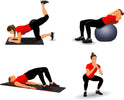
How to Improve Flexibility: Essential Stretching Exercises
, by Genetic Nutrition, 7 min reading time
Stay tuned, Your Favourite supplements will be back in stock soon!
Stay tuned, Your Favourite supplements will be back in stock soon!
Stay tuned, Your Favourite supplements will be back in stock soon!
Stay tuned, Your Favourite supplements will be back in stock soon!
Stay tuned, Your Favourite supplements will be back in stock soon!
Stay tuned, Your Favourite supplements will be back in stock soon!
Stay tuned, Your Favourite supplements will be back in stock soon!
Stay tuned, Your Favourite supplements will be back in stock soon!
Stay tuned, Your Favourite supplements will be back in stock soon!
Stay tuned, Your Favourite supplements will be back in stock soon!

, by Genetic Nutrition, 7 min reading time
Flexibility is important for both daily living and sports activities. It is sometimes disregarded, yet it is essential for a healthy body. Increasing your flexibility may yield several advantages, regardless of your level of experience or preference for fluid movement. It facilitates effective mobility, lowers the chance of accidents, straightens posture, and even boosts the ability to function well in a variety of physical activities. This blog dives into the subject of flexibility, examining important tactics and offering a thorough rundown of necessary stretching routines to assist you in developing a more flexible and agile physique.
Including a range of stretching exercises in your regimen will help you work on various muscle groups and increase your range of motion and flexibility. Try these crucial stretches that are listed below:
It is essential for performing daily tasks, including bending, reaching, and twisting, as well as for optimal sports and exercise performance. The capacity of a joint or set of muscles to move freely across their whole range of motion is referred to as flexibility. The following are some of the main advantages of flexibility training:
To increase the range of motion and flexibility, stretching involves extending and elongating the muscle fibres, tendons, and connective tissues. Over time, this reflex can help increase muscular suppleness and range of motion by causing the muscle to contract in reaction to the stretch. The stretch reflex is a reflex that is brought on by stretching a muscle, which causes tension in the muscle fibres.
Regularly performing both forms of stretching can help improve flexibility. Static and dynamic stretching are the two primary categories of stretching. Dynamic stretching is deliberately extending your range of motion, as with arm circles or leg swings, whereas static stretching is maintaining a stretched posture for a predetermined amount of time, usually 15 to 30 seconds.
Your flexibility, mobility, and posture will all improve with frequent practice of key stretching exercises that target main muscle groups. Enhancing performance in a variety of activities, avoiding accidents, and preserving general health all depend on increasing flexibility via stretching exercises. This will lead to a more active and healthy lifestyle. To reach your maximum potential and enjoy the long-term advantages of increased flexibility and mobility, begin implementing these crucial stretching exercises into your daily routine right now.
Buy your preferred nutrition supplements today on Genetic Nutrition and achieve your fitness goals.